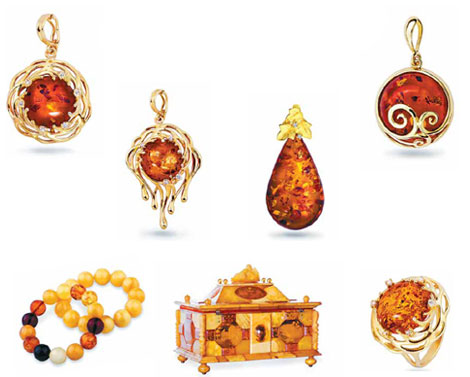Nordic gold
Updated: 2012-07-01 08:07
By Mike Peters (China Daily)
|
|||||||||||
|
An important export of Denmark for centuries, amber is prized in China because it is said to bring happiness, health and prosperity. |
Amber has been prized since ancient times, and jewelry crafted from this fossilized pine resin casts a warm glow from Denmark to China, Mike Peters discovers in Copenhagen.
It's 5 pm on a Saturday, and the group of Chinese tourists I'm following down Copenhagen's main shopping street is starting to show fatigue. A big lunch of smorrebrod, Denmark's famous open-faced sandwiches on dark rye bread covered with salmon and remoulade, had been followed by a little schnapps.
There had been no time for a nap. My new friends would board their plane back to Beijing in a matter of hours.
Instead, we were walking off that delicious lunch and seeking a few last gifts and souvenirs. We weren't having much luck, and the cobblestoned streets under our feet had begun to feel painful instead of charming.
Then we turned a corner, and suddenly the group was off at a near gallop. We'd arrived at the House of Amber, an institution here since 1933.
And we weren't alone. At least half of the shoppers swarming among the gleaming golds and yellows were Chinese, and so was about half the staff.
"It's not unusual for us to have 200 Chinese customers in a day during the summer season," says Lili Magnusson, the Danish woman who runs the front counter.
Amber washes up on Denmark's western shores like flotsam, and it's been prized here since the Stone Age, company chairman Henrik Busch tells me later.
"Amber is the fossilized resin of trees from ancient pine forests which existed more than 30 million years ago," he says. "Pieces of amber vary in color from milky white to golden and dark brown, orange and reddish, and even the clearest green and blue. Some pieces are transparent - both with and without small glittering pockets of air inside, while others are opaque."
It depends, he says, on where in the world the amber comes from and the conditions under which it was formed.
Folks like Indiana Jones have marveled at amber's ability to preserve insects and plants, which became trapped in the resin millions of years ago. "Irregularities such as insects, wood and air bubbles makes the pieces even more rare and valuable," Busch says.
The Chinese have been good amber customers for a long time, and today there are 36 House of Amber outlets around China. The most recent expansion has been in the northeast, including Harbin.
Prized for its beauty and warm glow since ancient times - no Viking fashionista was ever without amber - the stone has a special aura that is said to bring happiness, health and prosperity.
"For centuries, giving amber, amber jewelry and figures, or amber stones meant good fortune," Busch says, "and this is also one of the reasons amber is very popular in China.
"It is believed to protect you and cure you from diseases. Amber is one of the Seven Treasures of Buddhism," he adds, and as such it is believed to have calming effects - relieving stress, increasing alertness, giving inspiration, eliminating negative energies and offering protection by driving away evil.
Back in the shop, I express surprise that it's packed with Chinese, since they are clearly so familiar with the "Nordic gold" that they surely know they can buy it back home.
Magnusson acknowledges that with a smile, but she says the main store has special attractions.
"There is a lot more selection here," she says. "The price is a little better, and there is no tax or duty to pay."
There is also the adjacent Amber Museum, a shrine to amber's long history. Experts there guarantee the quality of each jewelry piece and keepsake in the store.
The museum and shop are located in Kanneworffs House, a charming old house - former seamen's quarters - dating back to 1606, making it one of the oldest buildings in Copenhagen.
In a country famous for design, some of the best pieces include amber set in 14- or 18-carat gold with diamonds.
"Scandinavian design is very popular in China as well as Denmark," Busch says, "and Danish companies in general are attractive to Chinese because of our history, Hans Christian Andersen and the Danish royal family."
Busch says the company plans to open up to a hundred shops in the coming years.
"We look at other markets," he says, "but are concentrating on our very fine relationships we have built in China over the past three years."
Contact the writer at michaelpeters@chinadaily.com.cn.
Today's Top News
Rescuers race against time for quake victims
Telecom workers restore links
Coal mine blast kills 18 in Jilin
Intl scholarship puts China on the map
More bird flu patients discharged
Gold loses sheen, but still a safe bet
US 'turns blind eye to human rights'
Telecom workers restore links
Hot Topics
Lunar probe , China growth forecasts, Emission rules get tougher, China seen through 'colored lens', International board,
Editor's Picks

|

|

|

|

|

|






